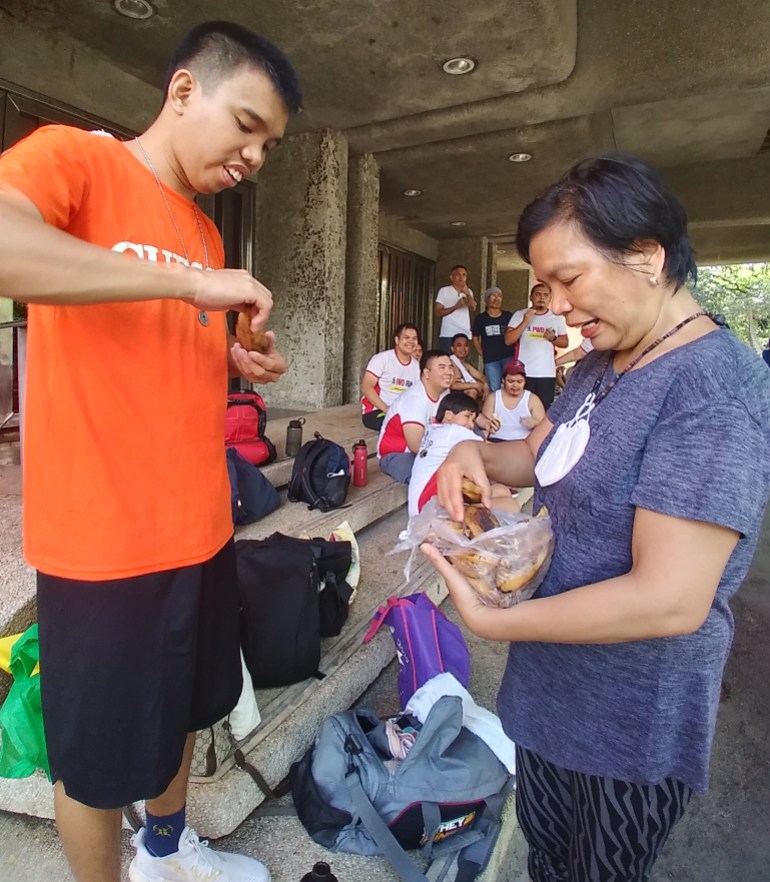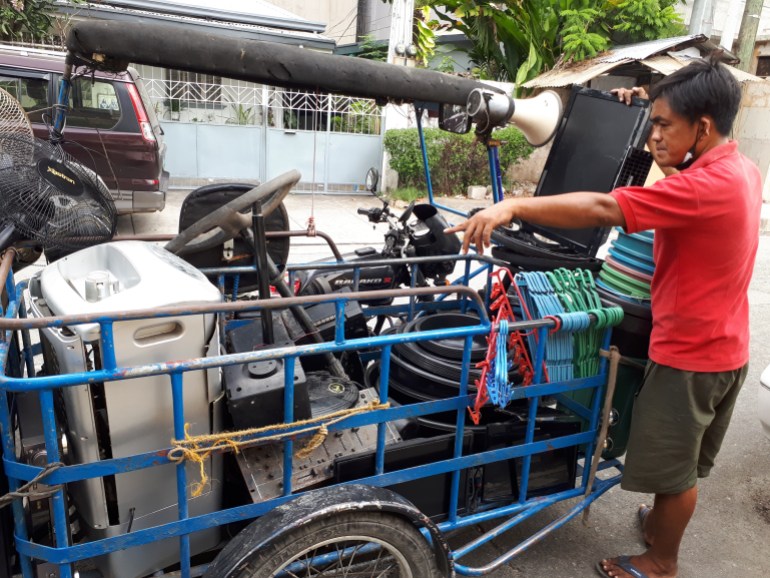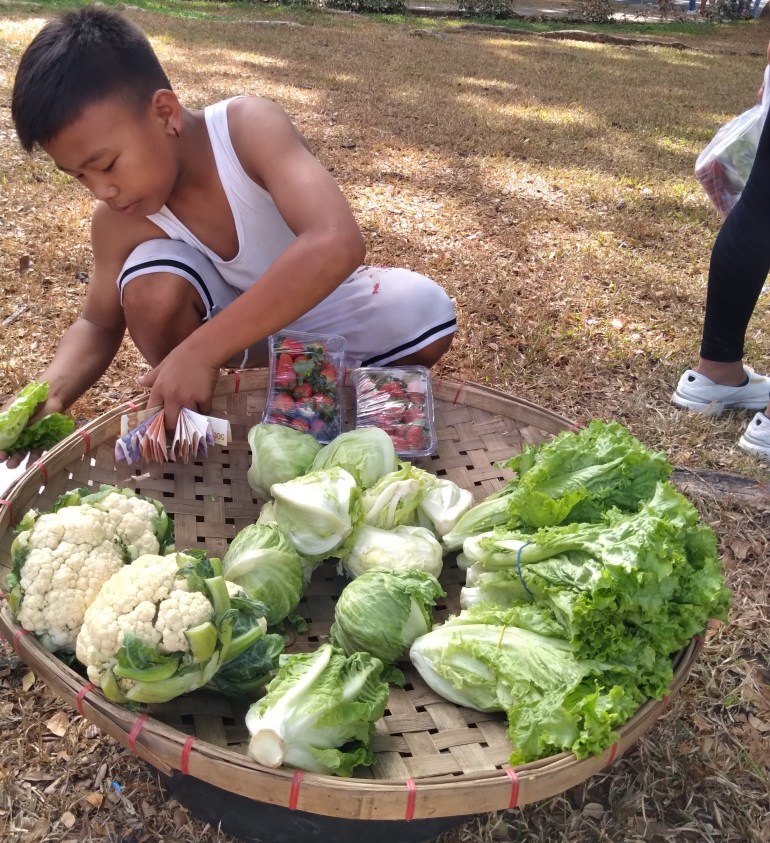Manila, Philippines – Emelie Ann Ducabo, 57, a married mother and sales worker in Metro Manila, has been forced to become an expert in pinching pennies to feed the seven members of her household.
At the market, Ducabo buys pork, fruit and vegetables in the smallest possible quantities, but pricier beef is totally out of the question. Instead of chicken legs and thighs, she opts for liver and necks, which she makes into noodle soup that she doles out to her husband, two grown sons, sister-in-law and her 94-year-old mother’s carer. Her mother follows a special diet of pureed fruits and oatmeal.
“The important thing is to draw the protein from these chicken parts that our body needs,” Ducabo told Al Jazeera.
Every member of the household drinks their morning coffee black, without sugar, and the occasional sweet treat is restricted to grated melon mixed with milk and crushed ice.
Despite their difficult circumstances, Ducabo is lucky to be able to attend to her boys and mother. She works mostly from home as a buyer at a garment firm. She and her husband own their 40-square-metre (430sq ft) house.
The only items Ducabo does not scrimp on are the detergent for washing her family’s clothes – “I want my boys smelling clean!” – the small native bananas that are always on the table for anyone who is hungry and her mother’s adult diapers and special diet.

Prices in the Philippines are soaring – and faster than anywhere elsewhere in Southeast Asia, apart from war-torn Myanmar and socialist Laos.
In February, inflation reached 8.6 percent – down a hair from the previous month – far outpacing Singapore, Malaysia, Thailand, Indonesia and Vietnam.
While most households are tightening their belts, the situation for lower-income families is particularly difficult.
Whereas wealthier Philippine households spend less than two-fifths of their income on food, those in the bottom 30 percent of the income distribution spend nearly 60 percent of their earnings on sustenance, according to government statistics.
Under a special Consumer Price Index (CPI) used to measure cost-of-living pressures for lower-income households, inflation in February hit the equivalent of 9.7 percent – unchanged from the previous month.
The Philippines is especially vulnerable to inflation due to a combination of factors, including high consumption taxes and elevated production and distribution costs following the privatisation of public utilities, said Rosario Guzman, head of research at the IBON Foundation, an economic think tank.
“The government can no longer intervene in pricing water and electricity rates. We have the highest electric rates in Asia next to Japan,” Guzman told Al Jazeera.
Then-President Rodrigo Duterte’s introduction of an excise tax on all petroleum products in 2018, on top of the existing value-added tax (VAT) of 12 percent, had an especially severe impact on the poor, Guzman said.
Her think tank calculated that every Philippine peso increase at the pump generated an extra 400 million pesos ($7.3m) a day for the government last year.
President Ferdinand Marcos Jr has dismissed calls to suspend the VAT or excise tax on fuel, blaming high pump prices on the war in Ukraine and other external forces.
Jonathan Ravelas, the former chief market strategist of BDO bank and now managing director of eManagement for Business and Marketing Services, said the cost-of-living crisis had exposed the Philippines’ overreliance on imported food.
“We have no food security,” Ravelas told Al Jazeera, noting that the weakness of the peso to the dollar had driven import costs higher.
“Duterte did not undertake [a] food security [programme] but just imported,” Ravelas said. “Now, Marcos Jr has no choice but to push food security.”
“Unfortunately, there is no shortcut to food security, and importation has its limits,” he added.
While the Philippine central bank has raised its benchmark rate to 6.25 percent, Ravelas said it needs to go further to bring down inflation.
“In my view, the Bangko Sentral should still raise overnight rates close to 7 percent and not stop at 6.5 percent,” he said.

For Alfredo Barrun Pineda, Jr, 43, the rising cost of living was enough to convince him to give up driving an air-conditioned taxi. Now he drives a motorcycle with a sidecar filled with plastic pails, tubs and hangers that he barters for broken electronic goods and appliances, which he then sells to junk or repair shops. A megaphone announces his presence in middle-class neighbourhoods.
“I earn as much from this as from a taxi,” Pineda told Al Jazeera. He stopped driving a taxi when he found himself paying 2,000 pesos to operate his vehicle for 300 kilometres. To cope with inflation, he said, his family eats “the cheaper vegetables”.
Pineda said he voted for Marcos, the son of former dictatorial leader Ferdinand Marcos, who had promised to bring down the price of rice to 20 pesos per kilo.
“Yes, it’s still 42 [a kilo], but that’s okay. His father did a lot and all those accusations [of plunder] against him aren’t true.”
Some Filipinos have sought out opportunities in the cost-of-living crisis.
Jan Carlo, 12, spends four days each week strolling the sprawling campus of the state university in suburban Quezon City, balancing a giant plastic basin on his head filled with fresh – and pricey – salad greens and strawberries from a vegetable stall his stepmother runs nearby.
He has identified his target market: students and matrons jogging or biking on campus who do not mind paying him 50 pesos ($0.92) per head of cauliflower or broccoli and 100 pesos ($1.84) for a small tub of fresh strawberries.
His side hustle allows him to earn a little more than the monthly minimum wage for adults – all of which he hands over to his stepmother – although he has recently cut back to free up his time for school, which he has only attended for two years.

“All of these vegetables I am carrying, all these are profit, because we already earned back [our costs] in my mother’s stall,” he told Al Jazeera.
In the meantime, families like Ducabo’s must constantly come up with their own ways to get by.
To save on transport costs, Ducabo’s husband, Donato, a security guard, sleeps in the barracks his company provides on most nights of the week.
Ducabo describes the one or two nights a week he spends at home as “our bonding moment”, when she makes a special effort to stir-fry pancit noodles with bits of vegetables and meat and make Shanghai-style spring rolls.
Ducabo said their situation was, ironically, in some ways better during the height of the COVID-19 pandemic because the government had given out free rice and other food.
“But now, nothing,” she said.
“If I get emotional about our situation and blame the government for the high cost of food, I would get a heart attack. So I decided to just go with the flow.”

